
Whether you’ve just acquired your first home with a yard or want to improve your existing slice of green, this guide aims to equip you with the foundational knowledge and techniques for maintaining a healthy, vibrant lawn.
From understanding the basics of grass types to mastering the arts of mowing, watering, and fertilizing, we’ll walk you through everything you need to know to create and maintain a yard that not only looks fantastic but is also a sustainable and enjoyable outdoor space for you and your family.
Understanding Your Grass Types
Before diving into the specifics of lawn care, it’s important to have a solid grasp of the different types of grass and their characteristics. The most common grasses used in residential lawns include cool-season grasses such as Kentucky bluegrass, tall fescue, and perennial ryegrass, and warm-season grasses like Bermuda grass, Zoysia grass, and St. Augustinegrass.
Understanding the type of grass you have in your lawn will help determine the best care practices throughout the year. For example, cool-season grasses thrive in cooler temperatures and often require more frequent watering, while warm-season grasses do well in hotter climates and can withstand drought conditions.
To identify the type of grass in your lawn, consult a lawn care professional or use online resources and guides specific to your region.
Mowing
Mowing is a crucial aspect of maintaining a healthy lawn as it not only keeps the grass at an appropriate height for aesthetics but also stimulates growth and root development. Here are some key tips for proper mowing:
- Set your mower blades at the recommended height for your specific grass type. This ensures that the grass is not cut too short, which can weaken it and make it more susceptible to diseases and weeds.
- Avoid mowing when the grass is wet to prevent clumping and uneven cuts.
- Do not remove over one-third of the grass blade length in a single mowing session.
- Alternate the mowing direction with each session to prevent grass from being pushed in one direction, which can lead to matting and bare patches.
Watering
Proper watering is crucial for maintaining a lush and healthy lawn. However, it’s important to find the balance between not enough water, which can result in wilting and browning, and too much water, which can lead to shallow root growth and fungal diseases. Here are some tips for efficient watering and lawncare for newbies:
- Water deeply and infrequently rather than giving your lawn light daily watering. This encourages deep-root growth and makes the grass more resilient to drought conditions.
- Water should be used early in the morning or at night to prevent evaporation during the hottest hours of the day.
- Adjust your watering schedule according to weather and season changes.
Fertilizing
Fertilizing is essential for providing the necessary nutrients for a healthy lawn. Here are some tips for proper fertilization:
- Conduct a soil test to determine which nutrients your lawn needs and in what quantities.
- Use a spreader to evenly distribute fertilizer, avoiding clumping or uneven application.
- Avoid fertilizing during drought or extreme heat, as it can damage the grass.
Additional Factors to Consider
- Aeration: This process involves creating small holes in the soil to allow air, water, and nutrients to penetrate the grass roots, leading to a healthier and more vigorous lawn.
- Weed Control: Keeping weeds at bay is essential for the health and aesthetics of your lawn. Identify common weeds in your area and use pre- or post-emergent treatments as needed.
- Pest and Disease Management: Regularly inspect your lawn for signs of pests and diseases. Early detection and treatment can prevent widespread damage.
- Seasonal Care: Adjust your lawn care practices to suit the changing seasons—for example, more frequent watering in summer and final fertilization before winter.
- Equipment Maintenance: Keep your lawn care equipment in good condition. Sharp mower blades make cleaner cuts, while properly calibrated spreaders ensure even fertilizer application.
- Mulching: Mulching grass clippings back onto the lawn can provide nutrients and help retain soil moisture.
- Overseeding: Introduce new grass seeds to your lawn to improve its density and appearance, which are particularly useful for repairing bare patches.
- Think Sustainably: Consider sustainable lawn care practices such as using organic fertilizers and pesticides, conserving water, and incorporating native plants into your yard.
How Professional Help Can Benefit You
While DIY lawn care can be rewarding and effective, there are numerous benefits to hiring a professional lawn care service. Here are some key advantages:
- Expert Know-how: Professionals possess deep knowledge about various grass types, soil conditions, and local climates. They can tailor a care plan specific to your lawn’s needs.
- Time-saving: Leaving the hard work to the experts frees up your time for other activities. Lawn care can be time-consuming, especially if you aim for top-notch results.
- Access to Professional Equipment: Lawn care services use high-quality, professional-grade equipment that might be too costly for the average homeowner to invest in. This equipment can provide superior results.
- Consistent Care: Professional services offer consistent care and maintenance. When life gets busy, your lawn won’t suffer from neglect.
- Problem Diagnosis and Treatment: Experts can quickly diagnose and treat lawn problems that might baffle the untrained eye, such as specific pest infestations or diseases, ensuring your lawn remains healthy.
- Customized Fertilization and Weed Control Programs: Professionals can create a fertilization and weed control regimen tailored specifically to your lawn, which is more effective than generic solutions.
- Aesthetic Excellence: Pros have the experience and tools to maintain your lawn aesthetically, enhancing your home’s curb appeal and potentially increasing its value.
Conclusion
Caring for your lawn requires proper techniques, consistent maintenance, and dedication.
By following these tips and considering professional help, you can achieve a healthy, vibrant lawn that will envy your neighborhood. Remember to enjoy the process and take pride in your beautiful outdoor space.
Leave a Reply